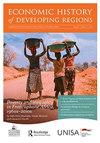Living standards of copper mine labour in Chile and the Central African Copperbelt compared, 1920s to 1960s
IF 0.8
Q1 HISTORY
引用次数: 1
Abstract
ABSTRACT Large-scale copper mining has been the main industry in Chile and the countries conforming the Central African Copperbelt for about one century. While a relatively extensive social science literature exists on the mostly adverse macroeconomic and institutional effects of a high reliance on mineral exports and revenues, we address the effects on the labour force employed by this industry. We perform a novel inter-continental – as well as dynamic-historical – comparative assessment of the living standards of the domestic copper mineworkers in the three countries from ca1920 to ca1960. There are important similarities and disparities in levels and trends of real wages and other welfare provisions. In explaining the gap across continents, we discuss labour shortage and labour provision, productivity, and mobilization. We also highlight the underlying role of colonialism in determining the inter-continental differences. Copper miners are further found to have been better paid than other workers in all three countries.20世纪20年代至60年代,智利和中非铜带铜矿工人的生活水平比较
一个世纪以来,大规模铜矿开采一直是智利和中非铜带沿线国家的主要产业。虽然存在相对广泛的社会科学文献,论述了高度依赖矿产出口和收入对宏观经济和制度的主要不利影响,但我们讨论了对该行业劳动力的影响。我们对1920年左右至1960年左右这三个国家的国内铜矿工人的生活水平进行了一项新颖的洲际以及动态的历史比较评估。实际工资和其他福利规定的水平和趋势有着重要的相似之处和差异。在解释各大洲之间的差距时,我们讨论了劳动力短缺和劳动力供应、生产力和动员。我们还强调殖民主义在决定大陆间差异方面的根本作用。进一步发现,在这三个国家,铜矿工人的工资都比其他工人高。
本文章由计算机程序翻译,如有差异,请以英文原文为准。
求助全文
约1分钟内获得全文
求助全文

 求助内容:
求助内容: 应助结果提醒方式:
应助结果提醒方式:


